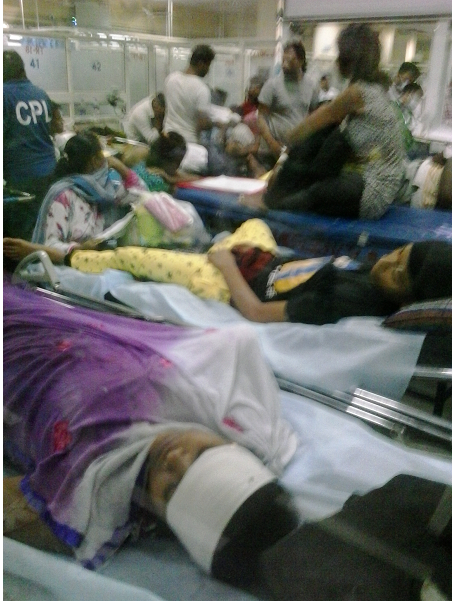DENGUE CRISIS EXPOSES NEGLIGENCE, POOR MEDICAL FACILITIES IN INDIA'S CAPITAL CITY
A quick picture of one of the general wards by Vishal Narayan

NEW DELHI: The death of seven year old child Avinash Rout of dengue after being turned away by hospitals, and the subsequent suicide by his parents has turned the spotlights on New Delhi, the national capital of India, that functions today without basic health care.
Dengue has claimed at least 15 lives already, with panicking citizens rushing to hospitals for admission at the first sign of fever. All hospitals are filled to over-capacity, with the major government institutions registering tired doctors, cranky nurses, hundreds of patients crowding the corridors, others lucky enough to be admitted fighting for space on a single bed even as the government of India and Delhi watch, mouthing little more than occasional platitudes.
The private hospitals who had been turning away dengue patients as well are now a little more careful following the death of the Rout family, but at least two of the major private facilities having little to no space for the poorer sections of society.
A total of 1800 dengue cases have been reported so far in the capital alone, reflecting the complete negligence and indifference of the capital’s civic bodies in dealing with the mosquito menace. Fumigation and sanitation that are necessary preventive measures have been given the go by, as Delhi crumbles under the epidemic, just as it dissolves into traffic jams after a light shower. Heavy rains paralyse the city with water flowing knee deep in posh South Delhi as well, and the sewage drains blocked with garbage overflowing onto the roads.
The Citizen visited two of the major government hospitals Safdarjang Hospital and the All India Institute of Medical Sciences (AIIMS). AIIMS was overcrowded, with the more fortunate of the patients managing to get admission in the “Emergency” general ward. But as this reporter found, there is nothing urgent about emergency ward either. The brother of a patient who was clearly very ill and lying on a stretcher said, “One doctor checked him in the morning and he said there’s nothing to worry about and you can go back, but the fever hasn’t abated yet and his condition is worsening. Now we are asking them to do anything, prescribe some medicine , anything, but now they’re saying that that doctor’s shift is over and we will have to wait until he returns.” They were from Varanasi.
There were just as many, may be more, patients waiting outside the Emergency Ward as there were inside. “Why have you brought her inside so early? You were told to wait outside,” snapped one of the guards when a man, who walked with the help of a stick, wheeled a young girl on a stretcher inside the ward.
A young doctor in the emergency ward, when asked how many dengue patients they were admitting every day, said, “we don’t take patients here now. There is hardly any space. I have been here for two hours now and have checked 15 patients, out of which six are definite dengue cases, including three very severe.” When asked whether the dengue situation is really alarming or just overblown, he said, “No, it’s not just media hype, the situation is indeed serious this year.”
The General Ward was out of bounds for non-patients at the Safdarjung Hospital, and the situation much worse than AIIMS. There was a long queue outside the ward of the patients who had been given a token number each and who were supposed to wait for their turn. The queue hardly moved and the same complaints of inordinate delay were heard. Many of the patients were visibly very ill, and in need of urgent medical attention but had been waiting for hours.
“We had done all tests at a local clinic and the fever was breaking, but then it suddenly shot up this afternoon and we had to rush to the hospital,” said Manoj, a Prahladpur resident in South Delhi, who along with his brother, Vishal, the patient, sat on the floor at the tail- end of the queue.
“We have been waiting here for more than two hours. My token number is 12 and they have called out for token number four only now,” said Manoj, who was wearing his t-shirt inside out, which he attributed to the error he made in hurrying his brother to the hospital.
The two government hospitals clearly lacked the resources---doctors, nurses, beds---to deal with the crisis. The UPA government had made land available to private medical hospitals at subsidised rates, but many of these have done away with the mandatory provision to treat a certain percentage of poor patients, except on paper. The crisis is now set to worsen.



